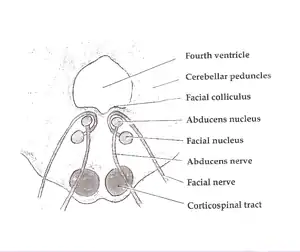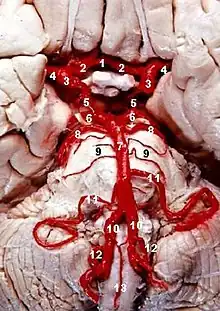Medial pontine syndrome
| Medial pontine syndrome | |
|---|---|
 | |
| Pons. (Medial pontine syndrome affects structures at the bottom of the diagram: the corticospinal tract, abducens nerve, and occasionally the facial nerve. Medial lemniscus is also affected, but not pictured.) | |
| Specialty | Neurology |
Medial inferior pontine syndrome is a condition associated with a contralateral hemiplegia."Medial inferior pontine syndrome" has been described as equivalent to Foville's syndrome.[1]
Presentation
Although medial pontine syndrome has many similarities to medial medullary syndrome, because it is located higher up the brainstem in the pons, it affects a different set of cranial nuclei.
| Structure affected | Presentation |
|---|---|
| Corticospinal tract | Contralateral spastic hemiparesis |
| Medial lemniscus | Contralateral PCML (aka DCML) pathway loss (tactile, vibration, and stereognosis) |
| Abducens nerve | Strabismus (ipsilateral lateral rectus muscle paralysis - the affected eye looks down and towards the nose). Abducens nerve lesion localizes the lesion to inferior pons. |
Depending upon the size of the infarct, it can also involve the facial nerve.
Cause

Human brainstem blood supply description. Basilar artery is #7, and pons is visible below it.
Medial pontine syndrome results from occlusion of paramedian branches of the basilar artery.
Diagnosis
Treatment
See also
References
- ↑ Hubloue I, Laureys S, Michotte A (September 1996). "A rare case of diplopia: medial inferior pontine syndrome or Foville's syndrome". Eur J Emerg Med. 3 (3): 194–8. doi:10.1097/00063110-199609000-00011. PMID 9023501.
External links
This article is issued from Offline. The text is licensed under Creative Commons - Attribution - Sharealike. Additional terms may apply for the media files.